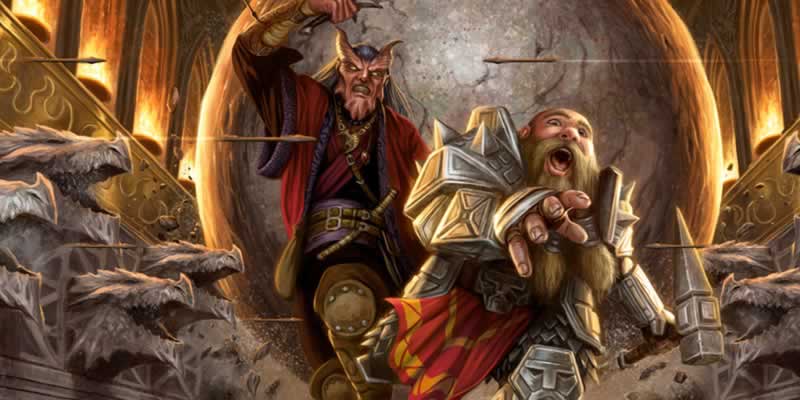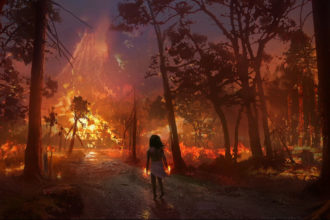4 Types of Dungeons & Building a Random Dungeon for D&D 5e

This week on the Campaign Trail I’m taking a quick look at one of the most popular adventuring environments, the dungeon. These labyrinths, full of death traps, starving monsters, and treasure hoards, test both GMs and players. Dungeons come in various forms such as lost temples, natural caverns, or even the lower hold of a sunken pirate ship. In this article, I’ll look at the four different types of dungeons and then I’ll start building a dungeon using the Dungeon Master’s Guide for D&D 5th edition.
The word dungeon comes from Old French donjon. The word is most commonly used to describe a room or cell in which prisoners are held, especially in a castle or underground.
In our fantasy tabletop RPG adventures, what we consider a dungeon is a much broader definition. The following are four broad categories to split dungeons into. These types are not perfect, but they work for the purpose of this article.
Types of Dungeons
RUINS
Ruins are dungeons that have been abandoned by their original creators long ago.
- Examples: a lost city, an abandoned mine, or a temple buried by an earthquake
- The original purpose of the dungeon has generally been lost to time, it is now in ruins
- Damage to the structures can be quite extensive with nature attacking it over time with weather exposure, creeping vines and flowing water
- A variety of creatures should have wandered in over the centuries, especially monsters looking for a place to wander around and wait for adventurers to come along that they can eat
- Ruins also make excellent lairs for larger monsters and their minions, such as dragons and kobolds
- Many of the original traps set by the creators will have been triggered, but you should leave the hardest to find secrets in place for your adventurers to discover
OCCUPIED
Structures are dungeons that are still in use and occupied.
- Examples: a home, a fortress, a temple, an active mine, a prison, or a headquarters
- Usually occupied by intelligent creatures, although they might not be the creators of the structure
- Likely to have organized guards and less likely wandering beasts
- Any traps or wandering monsters would be rare and should generally be controlled by the occupants
- You should find furnishings, decorations, and supplies that match up with the inhabitants, even if they are too expensive (stolen?) or worn-out (found?)
- You should place light sources in high traffic areas, unless the occupants have no need for light
- Your occupants should have the ability to freely move around the place, setting guard rotations and watches
- The structure could be partially occupied with a portion of the structure in ruins or under construction
VAULTS
Vaults are dungeons that protect something, usually by burying it underground.
- Examples: a bank vault, a labyrinth, a pyramid, a barrow, or the tomb of an ancient king
- The item that is being protected can be a fabulous treasure, a forbidden artifact, or the dead body of an important person
- Whatever the valuable object, it is placed in the vault surrounded by barriers, traps, and/or guardians
- Likely to have traps, especially magical traps that summon guardians
- Think of some physical and magical barriers to put in the way of your adventurers
- Least likely to have wandering monsters, since guardians are preferred
- Built for function over fashion, but these dungeons can be decorated with murals and statues, especially in tombs of important people.
- You should figure out the best way to provide a long term guardian (living or dead) for the vault
- If you must use living guardians, use magic to provide them with sustenance and rest, or just go with undead monsters or summoned monsters
CAVES & CAVERNS
Natural caves and caverns are dungeons that have formed naturally over time, providing a home for a variety of subterranean beasts and monsters.
- Examples: the Underdark, a thieves hideout, or an undersea cave full of pirate treasure
- Created naturally and connected by winding tunnels, cavern systems lack any sort of pattern, order, or decoration
- Encountering doors and traps should be unlikely as this is a natural environment
- Try creating large caverns full of mushroom forests, providing a place for your predators to hunt
- These caverns can be pitch black or you can create natural light sources using phosphorescence or magic
- Natural cavern complexes often connect with occupied dungeons such as mines and temples
- Cavern complexes can be as small as a couple of connected caves or as immense as the Underdark (or Pathfinder’s Darklands).
Regardless of which type of dungeon your players are exploring, provide interesting details for each room they enter. Letting them know that a room 20 feet wide by 40 feet long with a 10 foot ceiling is great… but tell give them details using all 5 senses. You don’t have to use all 5 senses in each room, choose what works and what they would experience with their passive perception.
- they hear dripping water or dragging chains off in the distance
- they see walls chocked with vines
- they smell putrid decay from down the hall
- they feel a cold draft as they enter the cavern
- they taste the old musty air as they enter the just unsealed tomb
Building a Dungeon – Part 1
Now it’s time to start building a dungeon using the tables in chapter 5 of the Dungeon Master’s Guide for D&D 5th edition. I made the following random rolls.
- Dungeon Location (d100): In a chasm
- Dungeon Creator (d20): Kuo-Toa
- Cults & Religious Groups (d20): Worshipers of an evil deity
- NPC Alignment (d20): Neutral
- NPC Class (d20): Ranger
- Dungeon Purpose (d20): Temple or shrine
- Dungeon History (d20): Abandoned due to plague
These rolls went pretty well and I think I have the start of a nice little dungeon.
In Part 2, I use a tool called the 5 Room Dungeon to build out a dungeon adventure.
If you liked this article and other articles here on Tribality.com, please consider supporting us on Patreon.



